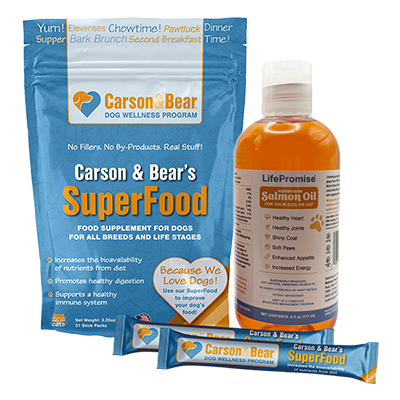Everyone, including your dog, feels better eating fresh foods. Providing fresh foods for canine companions is an emerging trend in pet wellness. Pet parents who care about their dog’s nutrition needs want to know how to avoid unnecessary fillers such as corn, wheat, and soy, which are cheaper sources of calories. Becoming better informed about dog food choices also gives you the opportunity to make more ethical and eco-friendly choices.
While there appears to be endless information and promotions about what to feed your dog, taking a closer look reveals many conflicting points about pet nutrition and what your dog needs. Pet owners find it confusing to understand and to be confident that they are feeding their dogs the right way when starting a fresh food diet.
Let us help simplify the fresh food questions and facts for you and take a closer look at the benefits of fresh food. For example, fresh food can improve digestion and reduce digestive problems, such as diarrhea and constipation. Fresh food is free of artificial ingredients that can trigger allergies in some dogs. Also, fresh food is more accessible for dogs to digest than kibble. When added to kibble that contains necessary nutrients, fresh food enables pet parents to go beyond the essential nutrients for their dog. It all can help to keep your dog’s coat shiny and healthy.
Also, dogs tend to prefer the taste of fresh food to kibble which can help picky eaters get the nutrition they need. When you feed your dog a fresh diet, you know exactly what they eat. This is important, as some commercial dog foods contain artificial ingredients and preservatives that can harm your dog’s health. If your dog has any health problems, you can also work with your veterinarian to create a fresh diet that meets its needs.
Boost Your Bowl With Small Steps
As much as you want the best for your pet, feeding your dog a fresh diet can be expensive and time-consuming. Don’t worry! You can boost your dog’s food bowl by adding fresh food toppers to regular kibble food. A fresh food topper is made of a few ingredients, such as meat, vegetables, and fruit, which go over or under the dog’s regular food. These toppers can be as simple as adding sautéed kale and broccoli to place on your dog’s plate or as complex as creating sauces and broths.
Fresh food toppers can offer several benefits for your dog’s overall health and wellbeing:
- Improved Hydration: Kibble food tends to be low in moisture content, which can lead to dehydration in dogs. Adding fresh food, such as vegetables, fruits, cooked meats, and bone broth can increase the moisture content of their meals, promoting better hydration and overall health.
- Enhanced Nutrition: Fresh food provides a more natural and diverse range of nutrients than kibble, which often relies on processed ingredients and synthetic vitamins. Adding fresh food can supplement your dog’s diet with important nutrients, including vitamins, minerals, and antioxidants, supporting their overall health and vitality.
- Digestive Support: Fresh food often contains prebiotics and probiotics, which are beneficial bacteria that promote a healthy gut microbiome. A balanced gut microbiome contributes to better digestion, nutrient absorption, and overall health, including gut health. Fresh food helps prepare the dog’s microbiome for new ingredients and introduces them to new tastes and textures.
- Palatability and Appetite Enhancement: Many dogs find fresh food more palatable than kibble, especially for picky eaters. Adding fresh food can make mealtime more enjoyable for your dog and encourage them to consume healthy food.
- Skin and Coat Health: Fresh food provides essential fatty acids, vitamins, and minerals, contributing to healthy skin and a shiny coat. A diet rich in fresh ingredients can help reduce skin dryness, flakiness, and other skin issues, promoting healthy and resilient skin and a lustrous coat.
- Weight Management: Fresh food is often lower in carbs than kibble, which can aid in weight management for overweight or obese dogs. Fresh food also provides more fiber, which can promote satiety and help dogs feel fuller longer.
- Overall Wellbeing: A fresh diet can contribute to well-being by supporting a healthy immune system, reducing inflammation, and promoting energy levels. A well-nourished dog is less likely to experience health problems and can enjoy an active and fulfilling life.
- Happier dog: A dog eating a healthy diet is likely to be happy and energetic. This can make for a more enjoyable and rewarding relationship between you and your dog.
- Stronger bond: Feeding your dog a fresh food diet shows that you care about their health and well-being. This can help to strengthen the bond between you and your dog.
- Reduced vet bills: A healthy dog is less likely to need expensive veterinary care. Fresh food toppers can help reduce the risk of various health problems, including obesity, allergies, and skin and coat problems.
- Peace of mind: Knowing your dog eats a healthy diet can give you peace of mind. You won’t have to worry about whether they are getting the nutrients they need to stay healthy.
- Improved nutrition for you: Many ingredients used in fresh dog food toppers are also great for humans. When you cook for Fido, you can make extra for yourself.
- Start slowly: If your dog is used to eating kibble, gradually introducing fresh food toppers is essential. Start by mixing a small amount of the topper with their kibble and progressively increase the amount of topper over time. Only increase topper use to the amount recommended on the Carson and Bear, not as much as they want, even though they will want more because it tastes so good.
- Cook in bulk: Save time later by cooking your dog’s food and freezing it in portions for use later. This saves you time on meal prep and makes it easier to feed your dog a fresh food diet daily.
- Use a slow cooker: A slow cooker is a terrific way to cook your dog’s food. Add all the ingredients to the slow cooker and let it cook on low for 8 hours.
- Make it fun: Feeding your dog a fresh food diet should be fun for both of you. Experiment with different recipes and find what your dog likes best.
- Be patient: It may take time for your dog to get used to eating a fresh diet. Be patient and don’t give up. With a bit of time and effort, your dog will enjoy the benefits of eating a healthy, fresh diet.



